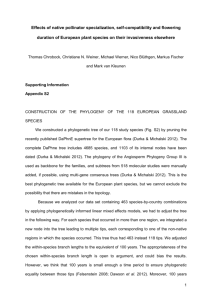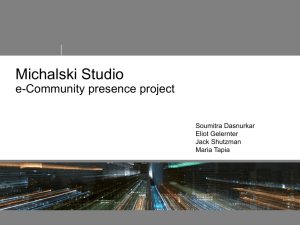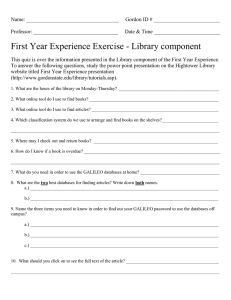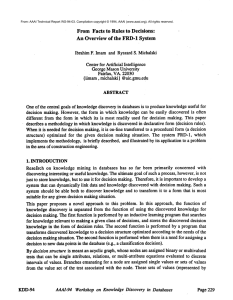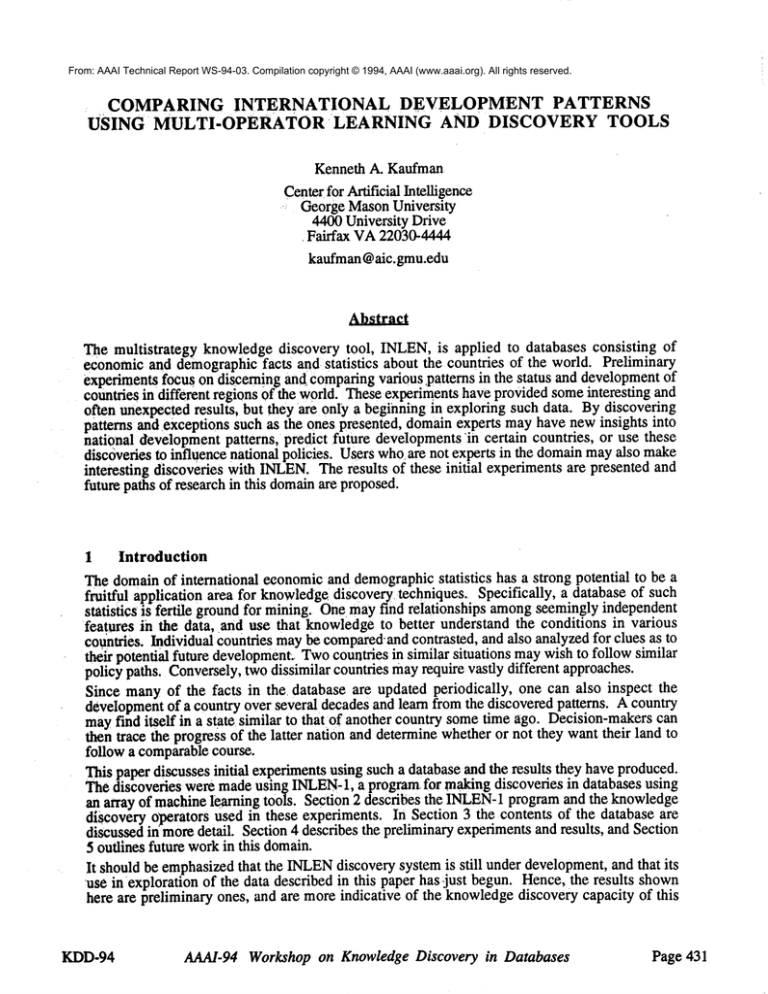
From: AAAI Technical Report WS-94-03. Compilation copyright © 1994, AAAI (www.aaai.org). All rights reserved.
COMPARING
INTERNATIONAL
USING
MULTI-OPERATORLEARNING
DEVELOPMENT
PATTERNS
AND DISCOVERY
TOOLS
Kenneth A. Kaufman
Centerfor Artificial Intelligence
George MasonUniversity
4400 University Drive
¯ Fairfax VA22030-4444
kaufman@aic.gmu.edu
Abstract
The multistrategy knowledge discovery tool, INLEN,is applied to databases consisting of
economicand demographicfacts and statistics about the countries of the world. Preliminary
experiments focus on discerning andl comparingvarious.patterns in the status and developmentof
countries in different regions Of the world. Theseexperimentshave provided someinteresting and
often unexpectedresults, but they are only a beginning in exploring such data. By discovering
patterns and exceptions such as the ones presented, domainexperts mayhave newinsights into
national developmentpatterns, predict future developmentsin certain countries, or use these
discoveries to influence national policies. Users whoare not experts in the domainmayalso make
interesting discoveries with INISEN.The results of these initial experiments are presented and
future paths of research in this domainare proposed.
1
Introduction
The domainof international economicand demographicstatistics has a strong potential to be a
fruitful application area for knowledgediscovery techniques. Specifically, a database of such
statistics is fertile ground for mining. Onemayfind relationsnips amongseeminglyinoepenaent
features iia the data, and use that knowledgeto better understand the conditions in various
countries. Individual countries maybe compared-andcontrasted, and also analyzed for clues as to
their potential future development~Twocountries in similar situations maywish to follow similar
policy paths. Conversely,two dissimilar countries mayrequire vastly different approaches.
Since manyof the facts in the database are updated periodically, one can also inspect the
developmentof a country over several decades and learn from the discovered patterns. A country
mayfind itself in a state similar to that of another country sometime ago. Decision-makerscan
then trace the progress of the latter nation and determine whetheror not they want their land to
follow a comparablecourse.
This paper discusses initial experimentsusing such a database and the results they have produced.
The discoveries were madeusing INLEN-1,a programfor makingdiscoveries in databases using
an array of machinelearning tools. Section 2 describes the INLEN-1 programand the knowledge
discovery operators used in these experiments. In Section 3 the contents of the database are
discussed in moredetail. Section 4 describes the preliminary experimentsand results, and Section
5 outlines future workin this domain.
It should be emphasizedthat the INLENdiscovery system is still under development,and that its
use in exploration of the data described in this paper has-just begun. Hence, the results shown
here are preliminary ones, and are moreindicative of the knowledgediscovery capacity of this
KDD-94
AAAI-94 Workshop on Knowledge Discovery in Databases
Page 431
methodologythan they are substantial contributions to understanding the domain.Throughfurther
interaction ~;¢ith the interested domainexperts, the discoveryprocess will be better focusedon their
specific areas of interest.
2
The INLEN Knowledge Discovery System
INLENis designed to serve as a platform for knowledgediscovery in databases that overcomes
some of the limitations of traditional knowledgediscovery systems. Manyof the tools in the
INLENpackage utilize symbolic machine learningmethods which, unlike purely statistical
methods,are able to conceptually explain theii findings and the conditions under whichthey hold.
Thus, one does not have to be a domainexpert to get a deep understandingof what a particular set
of results means.
Furthermore,traditional methodsare not able to alter the feature space in the database to improve
prospects for discovery. If a database contains information on the lengths, widths and heights of
objects but not their volumes,such methodswill have difficulty in makingdiscoveries that depend
closely on the volumes themselves~ The INLENarchitecture includes several operators for
modifyingthe ~presentation space through constructive induction, including operators for creating
newattributes based upon either the data itself or intermediate discovered knowledge,selecting
subsetsof a larger feature spacethat are better,suited for discoverythan the entire initial feature set,
and Combining
portions of separate, related databases into promisingviewsof the data.
One weakness of a symbolic machine learning-oriented approach is that manysuch learning
programshave the limitation of being task-inflexible, Le., they can only performone specific type
of learning or discovery task. Aclustering programwill not be able to discover simple equations
that characterize a table of numericdata while a programthat can learn such equations will fail to
m alce discoveries in non-numeric databases. INLENis designed to provide a multistrategy
environmentfor discovery, with different operators available for use dependingon the particular
task at hand. INLENalso features a modular architecture, in which separate programs are
integrated into the Systemas individual operators or groups of operators. By introducing new
programs into the system, one can add to its knowledgediscovery capabilities. Similarly, a
progr~n in INLEN
can be replaced by another that performsa similar task better according to some
measure. To comparethe performance for a given task of one programto another is beyondthe
scope of this paper; the software-oriented emphasisinstead lies uponthe integration of diverse
componentsinto a multistrategy knowledgediscovery system.
A detailed description of INLEN’s
architecture and the operators fromwhichit is built is given by
Michalski et al. (1992b). The idea of such ~l multi-operator approachto knowledgediscovery was
formulated by Michalski in the 1980s. Thefirst such effort, from which INLENderived muchof
its conceptual architecture, was lilac QUINSystem(Query and Inference), a combineddatabase
managementand data analysis environment (Michalski, Baskin and Spackrnan, 1982; Michalski
and Baskin, 1983; Spackman,1983). QUINwas designed both as a stand-alone system, and as
subsystemof ADVISE,
a large-scale inference system for designing expert systems (Michalski and
Baskin, 1983; Michalski et. al, 1987; Baskin and Michalski, 1989). The INLENarchitecture
expands on the architecture used by QUINby incorporating a number of new learning and
inference operators. Additionally, it maintains a more complex knowledgebase than QUIN’s,
whichwas designed primarily with expert system rule bases in mind.
In the last few years, newtools have been developed, in particular, more advanced inductive
lea .rning systems, e.g., AQ15(Michalski etal, 1986), AQI7(Bloedorn, Wnekand Michalski,
1993) and ABACUS-2
(Greene,~1988), and expert database systems (Kerschberg, 1986, 1987,
1988). The above systems have influenced the development of INLENand its components.
INLENalso draws upon the experiences of working with AGASSISTANT,
a shell for developing
agricultural expert systems (Katz, Fermanian and Michalski, 1987) and AURORA,
a generalpurpose PC,based expert system shell with learning and discovery capabilities, designed by
Page 432
AAAI-94 Workshop on Knowledge Discovery in Databases
KDD-94
Michalski and Katz (INIS, 1988). The kernel of INLEN-1(the prototype version of the system
uponwhich we have conducted these experiments) has growndirectly out of these.
INLEN-1includes a knowledgebase of simple decision rules, a prototype relational database,
¯ modulesfor easy management
of the data, and an extensive iaser-oriented menu-basedgraphical
interface. The knowledgegeneration Operators (KGOs)used by INLEN-1 consist of a subset
the full set of operators that will beincorporatedin later versions of the system. Theparticular
operators that were used in the experiments presented in this paper, CLUSTER,
CHARSET,
IMPROVE
and TEST,are described below:
CLUSTER: Conceptual Clustering
CLUSTER
is an operator used to discover different waysof classifying an input set of examples.
It does so by creating logical divisions of the data into two or moregroups, formingconceptual
descriptions of the groups, and evaluating the quality of those descriptions, Thedescriptions can
¯ be used in selecting particular groupings of the data. In the examplepresented in Section 4, a
Clustering is chosen that divides the examplesbased on one attribute and then partitions each
subgroupaccording to another attribute in a mannerthat suggests a large set of representative
examplesand a :small setof exceptions in each subgroup, The programto performthese clustering
tasks is based on CLUSTER/2
(Michalski, Stepp and Diday, 1981; Michalski and Stepp, 1983;
Stepp, 1983, 1984).
CHARSET:Characterize and Differentiate
Sets of Events
CHARSET
learns decision rules from sets of examplesof different classes. Parameters can be set
to learn characteristic rules (very specific rules that fully characterize the examplesof an input
class), discriminant rules (maximally general rules that provide sufficient information
differentiate betweenthe classes of examples),or rules:of intermediate generality that best satisfy
other user criteria. The methodUsed in these experiments employsthe AQ15learning program
(Michalski et at, 1986) ’to ’learn characteristic rules. AQI5discovers classification rules
examiningdifferent generalizations of a "seed" exampleaccording to user-defined selection criteria
and creating a rule based on an optimal such generalization.
IMPROVE: Improve Knowledge Base
The I1VIPROVE
operator can be used in several ways, each with the goal of improving existing
knowledge.Oneform of this operator is incremental learning, in which newly available data is
matchedup with the existing knowledge,and inconsistencies are resolved through fine-tuning of
the knowledgebase. Another form is rule optimization, demonstrated in Section 4, in which
decision rules, ratherthan examplesare the input to the AQ15learning module.Here, the portion
of the event space coveredbya rule serves as the seed, and it is maximallygeneralized so as not to
extend into areas coveredby rules for other classes. In the exampleshownhere, discriminant rules
are generated from existing characteristic ones. By doing so, we can often learn moresuccinct
knowledgethan if we had learned discriminant rules directly from examples(Cuneo, 1975).
TEST: Test Knowledge
A knowledge-testing operator implementedusing the ATESTprogram (Reinke, 1984), TEST,was
also used in these experiments. A set of rules and sometesting examplesare the input to this
operator, ATEST
examineseach exampleand determines whether or not it is correctly classified
by the ruleset (based on exact matchwith its proper rule). If it is not, the exampleis set against
every rule in the ruleset to determinethe degrees of matchbetweenthe rules and the example.The
system judges the rule with the highest degree of match as being the best match for the example.
ATE
STcan summarizeits findings in three ways: by showingthe percentages of examples that
matchtheir target class both exactly and through~bestfit,’by creating a table showingthe percentage
of examplesof each class classified by the rules into each class, and by showingthe degrees of
matchfor each class for the individual examples.
KDD-94
AAAI-94 Workshop on Knowledge Discovery in Databases
Page 433
3
Data Description
These experiments were performed upon a database provided bythe World Bank that contains
information on 171 countries. For each country, 95 attributes were measured(whenavailable) for
each year between 1965 and 1990 inclusive. Manymore attributes could be constructed by
measuring changes in values from one year to another or by combining related features. For
example, although no information was explicitly available on the average education attained by
womenin a country’s labor force, this could be generated from the male and overall education
statistics as well as the male/female
labor force ratio.
In general, the features in the database deal with the quality of life and the economicconditions in
the various countries. Of these attributes, the ones used in one or both of the experiments
described below (since the focus of the first experiment shownhere was more demographic,and
the focus of the second was moreeconomic,the feature sets used were not identical) included the
following:
¯ Annual Population Growth Rate
¯ Population Density
¯ UrbanPopulation Percentage
¯ Percentage of Population BetweenAges16 and 64
¯ Changein the Percentage of the Population in the LaborForce during the 1980s
¯ Percentage of the LaborForce in Industry
¯ Percentage of the Labor Force in Agriculture
¯ Percentage of LandDevotedto Agriculture
¯ Life Expectancy
¯ Fertility Rate
¯ Death Rate
¯ Infant Mortality Rate
¯ Per Capita GNP
¯ Percentage of GDPdevoted to Agriculture
- Percentage of GDPdevoted to Medicine
" ¯ Percentage of GDPdevoted to Education
¯ Percentage of Children CompletingPrimary School
Each of these features is represented in the database by numerical values, typically with one
decimal place where appropriate, To facilitate the learning, the values were quantized into
intervals, with the intervals being selected based on either the distribution of the values or
groupings that had extra semantic meaningfor a humanuser (for example,by tens), as best suited
the data, In the results shownbelow, the values are given in a simplified but equivalent form for
ease of understanding.
Initial Experiments on the World Bank Data
4
The motivation and focus of these experimentswere based on discussions with the domainexperts
with whomwe have been collaborating; It is through these discussions that we chose to
¯ concentrate on certain parts of the worldand on certain indicators tending to have direct relevance
:tothe quality of life in those areas. Theselection of the learning operators wasuser-driven based
on both the presence of specific goals at the current stage of the knowledgediscovery process and
the output from previous steps.
Ourfast experimentfocused on discovering characterizations for countries in different parts of the
world by learning and comparingpatterns for different regions and searching for interesting
behavior in those countries thatdid not follow the local pattern. Wechose a set of quality-of-life
indicators from the database and all of the countries from Eastern Europeand the Far East for
whichmost of that information was available.
Page 434
AAAI-94 Workshop on Knowledge Discovery in Databases
KDD-94
The goal of this experimentwas to generate descriptions contrasting the "Eastern European"model
from the "Far Eastern" one. Secondarily, we were interested in seeing if any of the European
countries appearedto have conditions similar to those in the Asian pattern of development.If so,
they might be well-advised to examinethe policies of the Asian countries and try to follow the
paths of the more successful ones while avoiding the pitfalls of the struggling nations.
Conversely, the Europeannations that showedfar different conditions from those in the Far East
wouldlikely be best Served by the implementationof a different set of policies, given that they
wouldhave to operate Undera different set of assumptions.
Anothergoal was to identify someof those conditions that wouldtend to determine whetheror not
a country is "Far-East-like" in order to ascertain easily whethera country is convergingwith this
model or movingawayfrom it. It maybethe case, for example, that Bulgaria and Malaysia have
little in common
right nowin terms of these key indicators, but that they maybecomemoresimilar
several years in the future. In this way, using some concise decision rules, similarities and
dissimilarities maybe tracked.
Thefirst step in this experimentwasto apply conceptualclustering to the set of countries. Mostof
the sets of groups created by theclustering programdid not highlight the differences betweenthe
regions, but one four-group division did exactly that. Twoof the groups consisted of Eastern
Europeancountries while the other two held only Far Eastern ones. Each pair of groups from the
same region was divided into two individual groups by (amongother things) the change in each
country’s labor force participation percentage. That is, one of the Eastern Europeangroups
consisted of countries in whichthat figure wasbelowa certain threshold, while the other held ones
"with higher values.~ Similarly, the Asian countries were divided into two by this feature, albeit
with a different threshold markingthe division point.
It should be emphasizedthat differences in other features also distinguished the individual groups.
However,the region and the changein labor force participation are focused upon here due to the
clarity with whichthey defined group membership.
Interestingly, most of the European countries (there were only two exceptions - Albania and
Romania)had labor force percentage changes below the threshold at which the region’s countries
were divided. Similarly, all but two of the Asian countries (Cambodiaand Laos) had changes
above their threshold. One hypothesis to consider was that the two European countries with
above’thresholdlabor force changesmight :be following closer to the general Asian modelin other
respects, and the two Asian countries with below’threshold changes could be moreEuropean-like
in Outlook. Henceour next step wasto regroup the countries based.on whetherthey were above or
belowtheir region’s threshold and then use AQ15to learn rules describing the two groups. These
are the four rules that AQ15discovered:
Class is Ciassl (Asian-Like) if:
A.i.Changein LaborForce Participation > slight_gain,
2.Percentage of Labor Force in Industry < 40%,
3.Population GrowthRate > 0,
4.Life Expectancy> 60,
or
B. 1.Regionis Far East,
2.Percentage of LaborForce in Industry _< 30%,
3.Life Expectancyis in 60s,
4.Population GrowthRate > 2%,
5.Working Age Population < 64%,
6.Agricultural LandArea is not 30%to 50%,
7.Population Density is sparse,
8.Changein LaborForce Participation is near 0.
(total 9, unique9)
(total 2, unique2)
Class is Class2 (Asian-Unlike) if:
KDD-94
AAAI-94 Workshop on Knowledge Discovery in Databases
Page 435
A. 1.Changein LaborForce Participation is near 0 or decreasing,
2.Population Density < moderate,
3,Population GrowthRate is not 1%to 2%,
4.Percentage of Labor Force in Industry is not 20%to 30%,
5,Life Expectancyis not in 60s,
6.Agricultural LandArea is not 30%to 50%
(total 7, unique7)
or
B. 1.Percentage of LaborForce in Industry > 40,
2.Regionis Eastern Europe,
3.Agricultural LandArea > 50%,
4.Changein LaborForce Participation is near 0,
5.Population Density is moderate,
6.Population GrowthRate < 1%,
7.Working Age Population > 64%,
8.Life Expectancyis in 60s.
(total 1, unique1)
The numberedconditions in each rule are ordered on the basis of expected informativeness, based
on the numberof examples of the class and the numberof overall examples covered by that
condition. Thus in Rule 2A, Changein Labor Force Participation being near 0 or decreasing is
muchstronger evidence that a country is "Asian-Unlike"than if its Agricultural LandArea is not
between 30% and 50%.
The "total" and "unique" weights for each rule showrespectively howmanyof the countries were
¯ described by the entire rule, and howmanywere described by that rule and none of the other ones
learned. In each of the classes, Rule Ais a "heavyweight"rule, i.e, it covers the majority of the
examplesof the class. Rule B, then, accounts for the countries not described by Rule A.
Rule 1A, in particular, gives a concise characterization-of what Albania and Romaniahave in
common
with most of the Far Eastern nations. In addition to the defining condition of change in
labor force participation, they also share a certain commonality
in terms of industrial labor force,
population growthrate and life expectancy.
Rule 2A describes most of the countries that do not follow this Asian model. They can be
characterized by low population densities, decreases in labor force participation, and a lack of
moderatevalues in manyof the other attributes.
To try to better encapsulate this knowledge,we then took the learning a step further by applying
"rule optimization’~ - using AQto learn fromthe riales it created earlier. In doingso, AQsimplified
the rules and diminished the effects of tautological conditions. The optimization of the above
characteristic rules into discriminantones generatedthe following:
Class is Ciassl (Asian-Like) if:
A.l.Changein LaborForce Participation > slight_gain,
or
B. 1.Working Age Population < 64%,
2.Life Expectancyis in 60s.
Class is Class2 (Asian-Unlike) if:
A. 1.Life Expectancyis not in 60s,
2.Changein LaborForce Participation is near 0 or decreasing,
or
B.l.Percentage of Labor Force in Industry > 40.
In this case, the key elements to look for were found to consist of the change in labor force
participation, life expectancy, workingage population, and industrial labor force percentage.
These characteristics were found to most directly link conditions in Albania and Romaniato those
in the nations of the Far East, and to distinguish those in the rest of Eastern Europefromthem.
Page 436
AAAI-94 Workshop on Knowledge Discovery in Databases
KDD-94
¯ The second experimentinvolved a larger set of attributes from the database and a larger set of
countries, based upon the Suggestion of a domainexpert workingwith the WorldBank. For this
experiment, we defined seven country groups (North America (USAand Canada), Western
Europe (including Oreat Britain and Scandinavia), ¯SoutbemEurope (the Iberian and Hellenic
peninsulas), Northeastern Europe (Eastern Europe north of the Balkans), Southeastern Europe,
Latin Americaand the Far East). In each of these regions, one or more "core countries" were
selected as being typical of the region.
Thegoals of this experimentwere to discover somecharacteristics of the various regions in terms
of quality of life, organizationallevel, wayof life, etc.; to detect interesting differencesbetweenthe
regions; and to examinetbe behavior 0f countries outside the core groups and analyze howthey
comparedto the morerepresentative nations of their region.
First weapplied AQ15to the individual regions, both through rule learning and rule optimization,
to learn what characterizes them and what differentiates them from other parts of the world. Some
strong trends were discove~d. South Americancoun~es (allof the Latin Americancore countries
were South American):could be characterized bYvery high population growthand fertility rates,
high infant mortality and loW per-capita GNPand life ¯expectancy. Western European core
countries had high per-capita GNP,low infant, mortality ’and low percentages of workers in
agricultural fields. Eastern Europeancountries showedlow life expectancies and low per-capita
GNPs,but while those in the nortbempart of the region Werealso characterized by high death rate,
high primaryschool education and moderate-to-highinfant mortality, those in the southern part of
the region exhibited low urbanization, slow population growthand relatively highly agriculturally
based economies. Southern Europe showedlow allocation of resources to education, moderateper
capita GNPand low fertility. Thecore countries in the Far East were characterized by a very low
deathrate.
Wethen applied the ATEST
operator to these characterizations by applying them to someof the
other countries in the region and examininghowwell the descriptions matchedthem. The "core"
countries had tended to be moderate, to,large ones in their regions - representative while not
¯ dominating,The additional countries were smaller or larger, or were regarded as not being typical
of their region (for example,Italy wasconsidered to be closer in nature to its WesternEuropean
neighbors than to the Mediterranean countries with whomit was geographically lumped.
Similarly, Mexic0wasthought to have more in commonwith South Americancountries than with
the other large nations of NorthAmerica.)
Welearned that the South Americanpattern was very strong throughout the continent and up to
Mexico.Paraguaydeviated farthest from it, but did not comeclose to fitting any other patterns
¯ with the possible exception of the Southeastern Europeanpattern. DevelopingEast Asian nations
also tended toward the South American model, AS .expected, cultural similarity outweighed
geographical similarity with respect, to Italy and Mexicoand the People’s Republic of China, the
latter moreclosely resembling the formerly Communist
countries ¯in Southeastern Europethan its
Far Eastern neighbors. Interestingly, Canadamoreclosely resembledthe developednations of the
F..ar. East than it did the UnitedStates. Perhapsdue¯to ¯being isolated by water, Iceland and Ireland
did not resemble Westernand NorthernEur0peas muchas Other test countries from the region did,
including non-aligned Switzerland. (The United Kingdom,as part of the core training set, had
already had its characteristics incorporatedinto the knowledgebase.)
5
Discussion of Results and Future Research
The results from these initial experiments have been encouraging. A few simple operations have
¯ generated results that were interesting and sometimesunexpected. The discovered knowledge
showedevidence that would confirm some hypotheses about the countries of the world, while
providingevidencethat contradicted others.
KDD-94
AAAI-94 Workshop on Knowledge Discovery in Databases
Page 437
Clearly, this has not been anythingnear anexhaustivesearch through the data, but rather an initial
foray into a rich area of knowledge.Weintend to progress to experiments with new and larger
sets of data from this database, and also t0 Workwith similar data from other sources. Countries
from other parts of the world such as the Middle East, Sub-SaharanAfrica, South Asia, Oceania
and the Caribbeancan be incorporated into future work.
Wealso plan to begin constructing and workingwith derived attributes that maybe better suited
¯ towardpointing0utpatterns in the data, and start to incorporatetemporalfactors by includingda.. ta
taken from different years and using statistical and machinelearning-based programsto aetermme
which years and differentials thereof have¯ the greatest potential for leading us to interesting
discoveries.
INLENis also growing, and as such will contain more tools for different forms of knowledge
¯ discovery. Fromthe current version of the system, which Can be applied to larger data sets th~
before, further expansionis taking place, Operators are being added for attribute selectton ann
construction, for examplese|eetion, for discovering relationships within the knowledgebase, for
knowledgerepresentation and Use by decision trees, and for statistical processing. The entire
systemis beingalso convertedinto a platform’independenttool that will allow for direct interaction
with moredatabases.
Theresults described here provide further support to the hypothesis (Michalskiet al, 1992a)that
tool such as INLEN
can be used¯ for makingdiscoveries in data by non-experts in the data domain.
Byputting a robust knowledgediscovery tool whoseoperation can easily be learned into the hands
¯ of domainexperts, the experts willbe able to conduct wide or narrowsearches through databases
in order to makediscoveries thatthey will find interesting and important.
Acknowledgments
The author thanks the WorldBank for providing the data used in this research and Tiber Vamos
for both his insighis in approaching this domain and acting as a liaison between the INLEN
development team and the World Bank. The author also thanks Eric Bloedorn for his comments
and criticism.
This research was conductedin the Center for Artificial Intelligence at GeorgeMasonUniversity.
The Center’s research is supported in part by the AdvancedResearch Projects Agencyunder the
grant No. N00014-9¯l-J- 185¯,], administered by the Office of NavalResearch, and under the grant
~o, F49620-92-J-0549,¯administered bythe Air Force Office of Scientific Research, in part by the
Office of Naval Research under the grant No. N00014-91-J-1351,and in part by the National
Science Foundation under the grant No. IRI-9020266.
References
Baskin,A.B.and Michalski,R.S., "AnIntegratedApproach
to the Constructionof Knowledge-Based
Systems:
Experienceswith ADVISE
and RelatedPrograms,"in Topicsin ExpertSystemDesign,Guida,G. and Tasso, C.
(eds.), ElsevierSciencePublishersB. V., Amsterdam,
1989,pp. 111-143.
Bloedorn,E., Wnek,J., andMichalski,R.S., "MultistrategyConstructiveInduction:AQ17-MCI,"
Proceedings
of
the SecondInternationalWorkshop
on MultistrategyLearning,HarpersFerry, WV,May1993,pp. 188-203.
Cuneo,R.P, "Selected Problemsof Minimalizationof Variable-ValuedLogic Formulas,"Master’sThesis,
Department
of Computer
Science,Universityof Illinois, Urbana,1975.
Page 438
AAAI-94 Workshop on Knowledge Discovery in Databases
KDD-94
Greene, G., "Quantitative Discovery: Using Dependenciesto Discover Non-LinearTerms," Master’s Thesis,
Department
of Computer
Science, Universityof Illinois, Urbana,IL, 1988.
International Intelligent Systems, Inc., "User’s Guideto AURORA
2~0: A Discovery System," Fairfax, VA,
InternationalIntelligent Systems,Inc., 1988.
Katz, B., Fermanian, T.W. and Michalski, R.S., "AgAssismnt:An Experimental Expert System Builder for
Agricultural Applications," Report No. UIUCDCS-F-87-978,
Departmentof ComputerScience, University of
Illinois, Urbana,IL, Oct. 1987.
Kaufman,K., Michalski, R.S. and Kerschberg,L., "MiningFor Knowledge
in Data: Goals and GeneralDescription
of the INLEN
System," in Piatetsky-Shapiro, G. and Frawley, WJ. (Eds.), KnowledgeDiscovery in Databases,
AAAIPress, MenloPark, CA,1991, pp. 449-462.
Kerschberg, L. (ed.), Expert Database Systems: Proceedings from the First International
Benjamin/Cummings
Publishing Company,MenloPark, CA, 1986.
Workshop,
Kerschberg, L. (ed.), Expert Database Systems: Proceedings from the First International Conference,
Benjamin/Cummings
Publishing Company,MenloPark, CA, 1987.
Kerschberg,L. (ed.), Expert DatabaseSystems:Proceedingsfrom the SecondInternational Conference,George
MasonUniversity, Fairfax, VA,1988. (to appear in bookform, Benjamin/Cummings
Publishing Company,
Menlo
Park, CA,1988.
Michaiski,R.S. and Baskin,A.B., "Integrating MultipleKnowledge
Representationsand LearningCapabilities in an
Expert System: The ADVISE
System," Proceedings of the 8th International Joint Conferenceon Artificial
Intelligence, Karlsruhe, WestGermany,
1983,pp. 256-258.
Michalski, R.S., Baskin, A.B. and Spackman,K.A., "A Logic-basedApproachto ConceptualDatabaseAnalysis,"
Sixth AnnualSymposium
on ComputerApplications in Medical Care (SCAMC-6),
GeorgeWashingtonUniversity
MedicalCenter, Washington,DC,1982, pp. 792-796.
Michalski, R.S., Baskin, A.B., Uhrik, C. and Channic, T., "The ADVISE.1
Meta-ExpertSystem: The General
Design and a Technical Description", Report No. UIUCDCS-F-87-962,
Department of ComputerScience,
Universityof Illinois, Urbana,IL, 1987.
Michalski, R.S., Kerschberg,L., Kaufman,K. and Ribeiro, J., "Searchingfor Knowledge
in Large Databases,"
Proceedingsof the First InternationalConferenceon ExpertSystemsand Development,
Cairo, Egypt, April 1992.
Michalski, R.S., Kerschberg,L., Kaufman,K. and Ribeiro, J., "Miningfor Knowledge
in Databases: TheINLEN
Architecture,Initial Implementation
andFirst Results," Journalof Intelligent InformationSystems:Integrating Al
and DatabaseTechnologies,Vol. 1, No. 1, August1992, pp. 85-113.
Michalski, R.S., Mozetic,I., Hong,J. and Lavrac, N., "The AQI5Inductive LearningSystem:AnOverviewand
Experiments,"Report No. UIUCDCS-R-86-1260,
Departmentof ComputerScience, University of Illinois, Urbana,
IL, 1986.
Michalski R.S., and Stepp, R.E., "AutomatedConstruction of Classifications: ConceptualClustering Versus
NumericalTaxonomy,"
IF.~ETransactionson Pattern Analysis and MachineIntelligence, 1983.
Michalski,R.S., Stepp, R.E. and Diday, E., "A RecentAdvancein Data Analysis: Clustering Objects into Classes
Characterized by Conjunctive Concepts," in Progress in Pattern Recognition, Vol. 1, L. N. Kanall and A.
Rosenfeld(Eds.), NewYork: North-Holland,1981,pp. 33-56.
KDD-94
AAAI-94 Workshop on Knowledge Discovery
in Databases
Page 439
Reinke, R.E., "KnowledgeAcquisition and RefinementTools for the ADVISE
Meta-Expert System," Master’s
Thesis, Department
of Computer
Science,Universityof Illinois, Urbana,IL, 1984.
Spackman,
K.A., "QUIN:Integration of Inferential Operatorswithin a Relational Database,"ISG83-13, UIUCDCSF-83-917,M.S. Thesis, Department
of Computer
Science, Universityof Illinois, Urbana,IL, 1983.
Stepp, R.E., "A Description and User’s Guidefor CLUSTERY2,
a Programfor ConceptualClustering," Department
of Computer
Science,Universityof Illinois, Urbana,IL, 1983.
Stepp, R.E., "Conjunctive Conceptual Clustering: A Methodologyand Experimentation," Ph.D. Thesis,
Department
of Computer
Science, Universityof Illinois, Urbana,IL, 1984.
Page 440
AAAI.94 Workshopon KnowledgeDiscoveryin Databases
KDD-94


